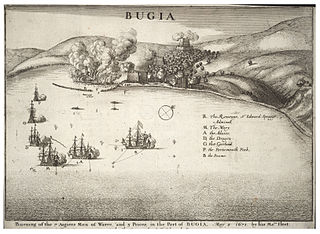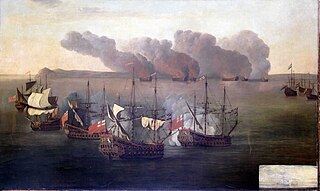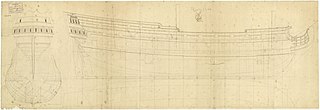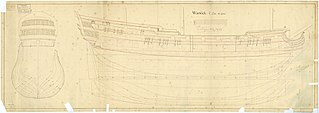
The siege of Derry in 1689 was the first major event in the Williamite War in Ireland. The siege was preceded by an attempt against the town by Jacobite forces on 7 December 1688 that was foiled when 13 apprentices shut the gates. This was an act of rebellion against James II.

HMS Dartmouth was a small frigate or fifth-rate ship, one of six ordered by the English Council of State on 28 December 1654, and built in 1655.

HMS St Michael was a 90-gun second rate ship of the line of the Royal Navy, built by John Tippetts of Portsmouth Dockyard and launched in 1669.

Constant Warwick was originally a 32-gun privateer, built in 1645 as a private venture between the Earl of Warwick and Sir William Batten and intended to operate as a privateer. Hired for service in the Parliamentarian navy during the First English Civil War, her captain William Batten defected to the Royalists during the 1648 Second English Civil War. After her crew mutinied in November 1648, she returned to England and was purchased by Parliament for the Commonwealth Navy on 20 January 1649. Described as an "incomparable sailer", she was noted for her sharpness and fine lines, and is considered by some as the first true frigate of the Royal Navy. Mainly used for patrolling, she was captured by the French in 1691.
Sapphire was a 38-gun fourth-rate of the Commonwealth of England. After commissioning she was actively involved in the First Anglo-Dutch War, participating in most major fleet actions. During the Second Anglo-Dutch War, she was only in the first two engagements then spent her time in Irish Waters and the Mediterranean. She was run ashore due to a pending attack by suspected Algerian pirates on Sicily in March 1670.
HMS Reserve was one of six 40-gun fourth-rate frigates, built for the Commonwealth of England under the 1650 Programme, after the Restoration of the monarchy in 1660 she was incorporated into the navy of the Kingdom of England. She partook in no major Fleet actions during the First Anglo-Dutch War. After the Restoration during the Second Anglo-Dutch War she partook in the Battle of Lowestoft, the Four Days' Battle and the St James Day Battle. She spent the bulk of her service either in the Mediterranean or at Newfoundland. She foundered off Yarmouth in November 1703.

Advice was one of six 40-gun fourth-rate frigates, built for the Commonwealth of England under the 1650 Programme, she would be transferred to the navy of the Kingdom of England upon the Restoration of the monarchy in May 1660. During her time with the Commonwealth Navy she would fight in two major fleet engagements of the First Anglo-Dutch War, this being the Battle of Portland and the Battle of the Gabbard. After the Restoration she would be involved in the Second Anglo-Dutch War specifically the Battle of Lowestoft and the St James Day Battle. She would also be present at the attack on the Vile or better known as Holmes Bonfire. She would see action against the Algerines at the Battle of Bugia. During the Third Anglo-Dutch War she would do battle at the Battle of Solebay, The Battle of Schooneveld and the Battle of Texel. She would also do battle against the French at the Battle of Bantry Bay. She would see service in both the West and East Indies before being rebuilt at Woolwich.

HMS Centurion was one of six 40-gun fourth-rate frigates, built for the Commonwealth of England under the 1650 Programme, she would be transferred to the navy of the Kingdom of England upon the Restoration of the monarchy in May 1660. When commissioned she partook in the First Anglo-Dutch War. After the first war ended she was in the Mediterranean fighting the Algerines at the Battle of Santa Cruz. She fought the battles of Dover, Portland, the Gabbard, and Scheveningen. During the Second Anglo-Dutch War she partook in the battles of Lowestoft and Orfordness. Following the second war she spent her time either in North America or the Mediterranean. She was wrecked in a storm in December 1689.
HMS Assistance was one of six 40-gun fourth-rate frigates, built for the Commonwealth of England under the 1650 Programme, after the Restoration of the monarchy in 1660 she was incorporated into the navy of the Kingdom of England. During her time in the Commonwealth Navy she partook in the First Anglo-Dutch War being present in the battles of Kentish Knock, Portland and The Gabbard. In the Mediterranean she was present at the Battle of Santa Cruz and the bombardment of Porto Farina, In the Second Anglo-Dutch War she was involved in the Battle of Lowestoft, Battle of Vagen and the St James Day Fight. She did not participate in fleet actions after this. She spent the rest of her service life undergoing several rebuilds and plying the waters as a cruiser protecting British trade and projecting British sovereignty. After nearly 95 years of Service she was sunk as a break water at Sheerness at the end of 1745.

HMS Jersey was a 40-gun fourth rate frigate of the English Navy, originally built for the navy of the Commonwealth of England at Maldon, and launched in 1654. By 1677 her armament had been increased to 48 guns.
HMS Berwick was a 70-gun third rate ship of the line of the Royal Navy, built at Chatham Dockyard during 1677/1679. After completion she was placed in Ordinary for 10 years. She was commissioned for the War of the English Succession 1689-1697, participating in the battles of Beachy Head and Barfleur. She was rebuilt between 1697 and 1700. She was commissioned for the War of Spanish Succession 1702-1712, participating in the battles of Vigo Bay, Capture of Gibraltar and Velez Malaga. placed in Ordinary in 1712, she was converted to a hulk at Portsmouth in 1715 before being broken in 1742.
HMS Burford was a 70-gun third rate ship of the line built at Woolwich Dockyard in 1677/79 as part of the Thirty Ships Programme of 1677. She fought in the War of the English Succession, including the Battle of Barfleur, before being rebuilt at Deptford in 1699, remaining as a 70-gun third rate. During the War of Spanish Succession she was mostly in the Mediterranean fleet and fought at the capture of Gibraltar and the Battle of Málaga in 1704 before being extensively repaired between 1710 and 1712 at Portsmouth Dockyard. Burford served in the Baltic in 1715 and 1717 before returning to the Mediterranean to fight the Spanish at the Battle of Cape Passaro in 1718. She was wrecked on the Italian coast in a storm on 14 February 1719.
HMS Elizabeth was a 70-gun third rate built at Barnards Yard at Deptford Green by William and Robert Castle of Rotherhithe in 1678/80. She held an active commission during the War of the English Succession fighting in all three major engagements. She was rebuilt at Portsmouth between 1699 and 1704. She was captured by the French off the Scilly Islands in November 1704. She was in the French Navy until she was deleted in 1720.

HMS Essex was a 70-gun third rate built by Sir Henry Johnson of Blackwall in 1678/79. During the War of the English Succession she fought in the last major action. She was rebuilt in 1699/1700. During the War of Spanish Succession she fought at Vigo Bay, the Capture of Gibraltar and Velez Malaga. She also fought at the Battle off Passero in 1718. She was rebuilt again in 1736-40. She was in action off Toulon in 1744. She was active in the Channel and against French ports during the Seven Years War. She fought at Quiberon Bay in 1759. She was wrecked in Quiberon Bay in November 1759.

HMS Kent was a 70-gun third rate ship of the line built by Sir Henry Johnson of Blackwall in 1677/79. She served during the War of English Succession 1699 to 1697, participating in the Battle of Barfleur. She was rebuilt in 1697/99. She served during the War of Spanish Succession 1702 to 1712 and partook in the Battles of Vigo and Velez-Malaga. She partook in the Battle of Passaro then served during the short war with Spain, December 1718 to February 1720. She was rebuilt in 1722/26. She spent the next thirteen years as a guard ship at Portsmouth. In the 1740s, she was off Cape Finisterre then in the West Indies. She returned home and was finally broken in 1744.
HMS Pendennis was a 70-gun third rate ship of the line of the Kingdom of England built at Chatham in 1677/79. She was in the War of English Succession. She was in the Battle of Bantry Bay. She was wrecked on the Kentish Knock in October 1689.

HMS Suffolk was a 70-gun third-rate ship of the line of the Royal Navy, built by contract of 20 February 1678 by Sir Henry Johnson at Blackwall. She participated in the War of the English Succession 1689 - 1697, in the Battles of Beachy Head and Barfleur. She was rebuilt in 1699. She was actively involved in the War of Spanish Succession 1702 - 1713. Her later career was as guard ship duties, deployments to the Baltic Sea and the West Indies. She was finally broken in 1765 after lying in Ordinary for almost twenty years.

HMS Kingston was a 60-gun fourth-rate ship of the line of the Royal Navy, built by Frame in Hull and launched on 13 March 1697. She had an eventful career, taking part in numerous engagements.

HMS Warwick was a 60-gun fourth-rate ship of the line of the Royal Navy, built to the 1719 Establishment at Plymouth by Peirson Lock. The keel was laid down on 1 April 1730, and the ship was launched on 25 October 1733, and completed on 24 August 1734.

Captain Wolfran Cornewall was an officer in the Royal Navy.











